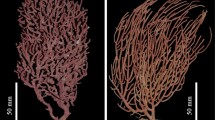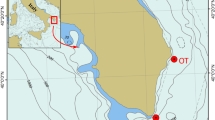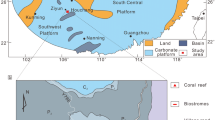Summary
Investigation of paleoecological successions in the shallow-marine Fatra Formation of the Western Carpathians reveals their tendency to grow into bioherms. However, this development was repeatedly interrupted at various stages; biostromes were destroyed by fluctuations in bathymetry and salinity, storms, subaerial exposure etc. Fatra Formation communities consist of a relatively variable spectrum of organisms, including also little known borers, etc. Organism communities only rarely reached the early mature stages of organization. The short-lived, interrupted successions within the early bioherms of the Fatra Formation may serve as a useful model for a biohermal development within ecologically restricted environments different from the optimal environments of many other Upper Triassic reefs.
Zusammenfassung
Die palökologische Untersuchung der flachmarinen Organismen-Assoziationen der Fatra-Formation (oberste Trias) in den Westkarpaten zeigt, daß die Entwicklung von Biohermen wiederholt unterbrochen wurde, wobei der Aufbau von Biostromen durch Schwankungen in der Bathymetrie und Salinität, durch Stürme oder durch Trockenfallen gestört wurde. Die in den Korallenkalken der Fatra-Formation auftretenden Kommunitäten umfassen ein relativ weites Organismenspektrum, in dem auch bohrende Organismen vorkommen. Die Kommunitäten erreichen jedoch in ihrer Organisation nur selten ein Reifestadium. Die im allgemeinen nur kurzlebigen ökologischen Sukzessionen innerhalb der Fatra-Formation stellen ein brauchbares Modell einer Bioherm-Entwicklung innerhalb von flachmarinen Bereichen mit eingeschränkten Umweltbedingungen dar.
Die Abb. 3 und 4 zeigen die Lithologie und die ökologischen Sukzessionen sowie die durch unterschiedliche Assoziationen ausgedrückten Stabilisations- und Kolonisierungsstadien in der Entwicklung der benthonischen Kommunitäten in den Biostromen bzw. Biohermen. Abb. 5 zeigt die Assoziationsfolge in einer flachen Lagune.
Similar content being viewed by others
References
ALBERSTADT, L.P., WALKER, K.R. & ZURAWSKI, R.P. (1974): Patch reefs in the Carters Limestone in Tennessee, and vertical zonation in Ordovician reefs.—Geol. Soc. Am. Bull.,85, 1171–1182, 10 Figs., Boulder
ANDERSON, E.J. (1971): Environmental models for Paleozoic communities.—Lethaia,4/3, 287–302, 6 Figs., Oslo
ANDRUSOV, D. (1959): Geology of the Czechoslovak Carpathians,2, 375 p., 34 Figs., Bratislava Slovak Acad. Sci.
ANDRUSOV, D., BYSTRICKY, J. & FUSAN, O. (1973): Outline of the structure of the West Carpathians.-Guide X. Congr. Carp.-Balkan geol. Assoc. 1973, 45 p., 5 Figs., Bratislava
AUSICH, W.I., KAMMER, T.W., & LANE, G.N. (1979): Fossil communities of the Borden (Mississippian) delta in Indiana and northern Kentucky.—J. Paleont.,53/5, 1182–1196, 7 Figs., Tulsa
BYSTRICKY, J. (1975): The Kössen Beds in the West Carpathians and the problem of their stratigraphical division.—Geol. zborn. Geol. Carpath.26/2, 177–197, Bratislava
ČEPEK, P. (1970): To the facies characterization of the neritic and bathyal sedimentation of the Alpine-Carpathian geosyncline.—Rozpravy Českoslov. Akad. véd, Matem.-Přír.,80/5, 78 p., 5 Figs., 17 Pls., Praha
COPPER, P. & GRAWBARGER, D.J. (1978): Paleoecological succession leading to a Late Ordovician biostrome on Manitoulin Island, Ontario.—Canad. J. Earth Sci.,15, 1978–2005, 9 Figs., Ottawa
DUFFIN, C. & GAŹDZICKI, A. (1977): Rhaetian fish remains from the Tatra Mountains.—Acta geol. Polon.,27/3, 333–348, 10 Figs. 2 Pls. Warszawa
FROST, S.H. & WEISS, M.P. (1979): Patch-reef communities and succession in the Oligocene of Antigua, West Indies: Summary.—Geol. Soc. Am. Bull.,90/7, 612–616, 2 Figs., Boulder
FÜRSICH, F.T. (1976): Fauna-substrate relationships in the Corallian of England and Normandy.— Lethaia,9, 343–356, 7 Figs., Oslo
— (1977): Corallian (Upper Jurassic) marine benthic associations from England and Normandy.— Palaeont.,20/2, 337–385, 31 Figs., London
GAŹDZICKI, A. (1974): Rhaetian microfacies, stratigraphy and facial development in the Tatra Mts.—Acta geol. Polon.,24/1, 17–96, 13 Figs., Pl. 19–52, Warszawa
GAŹDZICKI, A. & IWANOW, A. (1976): The diachronism of the Rhaetic and “Gresten” beds in the Tatra Mts. (West Carpathians).—Bull. Acad. Polon. Sci., Sci. Terr.,24/2, 117–122, 3 Figs., Warszawa
GAŹDZICKI, A., MICHALÍK, J., & PLANDEROVÁ, E., & SYKORA, M. (1979): An Upper Triassic-Lower Jurassic sequence in the Križna-nappe (West Tatra Mts., West Carpathians, Czechoslovakia).— Záp. Karpaty, Geol.,5, 119–148, 7 Figs., 10 Pls., Bratislava
GOETEL, W. (1917): Die rhätische Stufe und der unterste Lias der subtatrischen Zone in der Tatra.—Bull. Acad. Sci. Crac., A, 1916, 222 p., 6 Pls., Krakow
HICKEY, D.R. & YOUNKER, J.L. (1981): Structure and composition of a Pennsylvanian benthic community.—J. Paleont.,55/1, 1–12, 8 Figs., Tulsa
KOZUR, H. (1980): Revision der Conodontenzonierung der Mittel- und Obertrias des tethyalen Faunenbereichs.—Geol. Paläont. Mitt. Inssbruck,10/3–4, 79–172, 4 Figs., Innsbruck
KÜHLMANN, D.H.H. (1980): Coral associations and their value for paleontological research.,— Acta paleont. Polon.,25/3–4, 459–466, 1 Tab., Pls. 36–37, Warszawa
KÚŠIK, R. (1957): To the question of composition and origin of the Oravice oolitic ironores.— Geol. zbornik,8/2, 335–342, Bratislava (in Slovak)
KÚŠIK, R. (1967): Rhaetian and Lower Liassic sedimentary oolitic iron-ores of the Križna nappe.— Náuka o Zemi, Geol.3, 77 p. 10 Pls., Bratislava (in Slovak)
MAHEĽ, M. (1958): A contribution to understanding of tectonical sense of Krizna-unit structures and megastructures in Strázovská hornatina Mts.—Geol. práce, Zprávy,14, 9–12, Bratislava (in Slovak)
— (1979): Fatric and not Siprun: a new view onto tectonic subdivision and structure of the Tatrides.—Min. slovaca,11/3, 263–277, 5 Figs., Bratislava (English summary)
MAHEĽ, M. et al. (1967): Regional geology of Czechoslovakia II, 1.–486 p., 70 Figs., 56 Pls., Praha
MICHALÍK, J. (1978): To the paleogeographic, paleotectonic and paleoclimatic development of the West Carpathian area in the uppermost Triassic.—In: VOZAR, J. (ed.): Paleogeographical development of the Western Carpathians.-189–211, 10 Figs., Bratislava
MICHALÍK, J. (1979): Paleobiogeography of the Fatra-Formation of the uppermost Triassic of the West Carpathians.—Paleont. konf. 77, Univerzita Karlova Praha 1978, 25–39, 5 Figs., 2 Pls., Praha
— (1980): A paleoenvironmental and paleoecological analysis of the West Carpathian part of the northern Tethyan nearshore region in the lates Triassic time.—Riv. Ital. Paleont. Strat.85/3–4, 1047–1064, 8 Figs., Milano
MICHALÍK, J. & JENDREJÁKOVÁ, O. (1978): Organism communities and biofacies of the Fatra-Formation (uppermost Triassic, Fatric) in the West Carpathians.—Geol. zborn. Geol. Carpath.,29/1, 113–137, 12 Figs., Bratislava
MICHALÍK, J., JENDREJÁKOVÁ, O., & BORZA K. (1979): Some new Foraminifera-species of the Fatra-Formation (uppermost Triassic) in the West Carpathians.—Geol. zborn. Geol. Carpath.30/1, 45–60, 10 Figs., 4 Pls., Bratislava
MICHALÏK, J. & KOVÁČ, M. (1982, in press): To several problems of palinspastic reconstructions and Meso-Cenozoic development of the Western Carpathians.—Geol. zborn. Geol. Carpath., Bratislava
MICHALÍK, J., PLANDEROVÁ, E., & SYKORA, M. (1976): To the stratigraphic and paleogeographic position of the Tomanová-Formation in the uppermost Triassic of the West Carpathians.— Geol. zborn. Geol. Carpath.,27/2, 299–318, 8 Figs., Bratislava
MICHALÍK, J. & SYKORA, M. (1979): Fatra- und Kopieniec-Schichten in dem Profil Ráztoky des Nolčovo-Tales in der Grossen Fatra Gebirge.—Kmetiánum,5, 113–133, 11 Figs., Martin (German summary)
MIŠIK, M., JABLONSKY, J., FEJDI, P. & SYKORA, M. (1980): Chromian and ferrian spinels from Cretaceous sediments of the West Carpathians.—Miner. slovaca,12/3, 209–228, 7 Figs., 5 Tables, Bratislava
MIŠIK, M., MOCK, R. & SYKORA, M. (1977): Die Trias der Klippenzone der Karpaten. —Geol. zborn. Geol. Carpath.,28/1, 27–70, 3 Figs., 1 Tab., 8 Pls., Bratislava
MORBEY, S.J. (1975): The palynostratigraphy of the Rhaetian stage, Upper Triassic in the Kendelbachgraben, Austria.—PalaeontographicaB 152/1–3, 1–75, 3 Tables, 37 Figs., 19 Pls., Stuttgart
PERKINS, R.D. & ENOS, P. (1968): Hurricane Betsy in the Florida-Bahama area—geologic effects and comparison with hurricane Dona.—Geol.,76/4, 710–717, 2 Pls., Chicago
ROLLINS, H.B., & DONAHUE, J. (1975): Towards a theoretical basis of paleoecology: concepts of community dynamics.—Lethaia,8, 255–270, Oslo
ROLLINS, H.B., CAROTHERS, M. & DONAHUE, J. (1979): Transgression, regression and fossil community succession.—Lethaia,12, 89–104, 14 Figs., 6 Tables, Oslo
ROTH, Z. (1980): Western Carpathians-Tertiary structure of the Central Europe.—128 p., Praha (Academia) (in Czech)
ROZKOWSKA, M. (1980): On Upper Devonian habitats of rugose corals.—Acta paleont. Polon.,25/3–4, 596–611, 4 Figs., Warszawa
STACHE G. (1868): Über das Auftreten der Kössener Schichten im Gebiete der Hohen Tatra.—Verh. geol. Reichsanst.,5, 99–102, Wien
STUR, D. (1860): Über die Kössener Schichten im nord-westlichen Ungarn.—Sitzber. math.-naturwiss. Kl. Akad. Wiss.,38, 1006–1024, Wien
— (1868): Bericht über die Geologische Aufnahme im oberen Waag- und Gran-Thale.—Jahrb. geol. Reichsanst.,18/3, 337–426, Wien
UHLIG, V. (1897): Die Geologie des Tatragebirges.—Denkschr. Akad. Wiss., math. naturwiss. Kl.,64, 643–684, Wien
UNRUG, R. (1979): Palinspastic reconstruction of the Carpathian arc before the Neogene tectonogenesis.—Roczn. Pol. Tow. geol.,49/1–2, 3–21, 2 Figs., Krakow
WALKER, K.R., & ALBERSTADT, L.P. (1975): Ecological succession as an aspect of structure in fossil communities.—Paleobiol.,1/1/3, 238–257, Chicago
WATKINS, R., & AITHIE, C.J. (1980): Carbonate shelf environment and faunal communities in the Upper Bringewood Beds of the British Silurian.—Palaeogeogr., Palaeoclim., Palaeoecol.,29, 341–368, 16 Figs., Amsterdam
WIEDMANN, J., FABRICIUS, F., KRYSTYN, L., REITNER, J., & URLICHS, M. (1979): Über Umfang und Stellung des Rhaet. Diskussionsbeitrag zur Sitzung der Internationalen Subkommission für Trias-Stratigraphie in München, Juli 1978.—Newsl Stratigr.,8/2, 133–152, 6 Figs., 2 Tables, Berlin-Stuttgart
Author information
Authors and Affiliations
Rights and permissions
About this article
Cite this article
Michalik, J. Uppermost Triassic short-lived bioherm complexes in the fatric, western Carpathians. Facies 6, 129–145 (1982). https://doi.org/10.1007/BF02536682
Issue Date:
DOI: https://doi.org/10.1007/BF02536682




